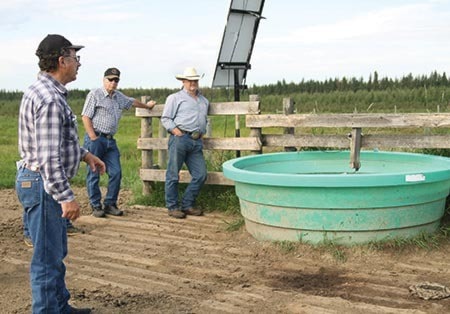Rather than keeping with traditional, direct pasture water systems for livestock, farmers are turning to options such as solar-powered pumping systems to better ensure the health of their herd and protect water sources from environmental damage.
According to the Government of Alberta’s Agri-Facts, herd health problems related to direct watering includes foot rot, leg injuries, stress, death from drowning or being stuck in the mud, reduced rates of gain, blue-green algae toxins and increased exposure to water transmitted diseases, bacteria and cyst infections.
Environmental issues with direct watering includes loss of water storage in dugouts and streams, damage to banks, rapid growth of weeds and algae, deterioration of water quality, and loss of riparian areas, vegetation, root systems and pastureland.
One such solar-powered system was developed by Kelln Solar; Kelln Solar distributor Randy Rob says the systems are customizable for farmers’ different needs, providing benefits beyond environmental care and herd health.
The system operates via a solar panel attached to a pump located in either the well or dugout. A float switch in the stock tank — which also has customizable features including water level detection and an alert time delay—measures the water levels and relays to the system when the tank needs more water.
Any time the water gets too low, if there is something wrong with the system or the pump turns on a cellular alert is sent to the farmer either by call or text. The feature is a time saver, especially for those who pasture cattle away from their residence.
The lines of communication are two-way and operators are able to have control over their system via cell phone. “You can just text it and say ‘start my pump’,” said Kelln Solar representative Andy Rob.
“It depends on how much information you want out of it,” added Randy.
The cell system becomes a challenge for those living in more remote areas without reliable cell service. Randy says at that point farmers may have to look at satellite systems, which are more expensive.
With the cost of solar power panels dropping Randy encourages farmers investing in solar power to oversize their systems to catch optimal solar energy.
Funding is available through the Growing Forward 2 On-Farm Stewardship Program. “It covers 50 per cent of your cost of year-round or summer watering systems (up to $30,000),” said Kim Barkwell, sustainable agriculture program manager for the counties of Wetaskiwin and Leduc.
“You need to have your environmental farm plan,” she added.
The On-Farm Stewardship Program funding includes: portable water systems, water storage, heat tape and heated waterers, frost-free nose pumps, pumping systems, power sources, plumping materials, pipelines, applicant’s equipment use and labour.
Ineligible costs include: generators, watering systems in farmyards or corrals, portable feed bunks, portable livestock corral panels and pump houses.
A few remaining items may be available for cost-share under the Growing Forward Water Management Program; water sources such as new dugouts or wells, dugout aeration systems, waterlines below frost level in a farm yard.
